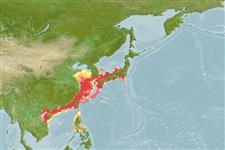Environment: milieu / climate zone / depth range / distribution range
Ekologi
laut; payau bentopelagis; oceanodromus (Ref. 51243); kisaran kedalaman 0 - 120 m (Ref. 43239). Temperate; 38°N - 13°N, 106°E - 141°E
Northwest Pacific: from central Vietnam to South Korea and Japan, Yellow and East China seas.
Length at first maturity / Size / Weight / umur
Maturity: Lm ?, range 17 - ? cm
Max length : 80.0 cm TL jantan/; (Ref. 4537); Berat maksimum terpublikasi: 243.60 g (Ref. 124479); Umur maksimum dilaporkan: 6 Tahun (Ref. 104735)
Duri punggung (Keseluruhan (total)): 9 - 10; duri punggung lunak (Keseluruhan (total)): 30-35; Duri dubur 2; Sirip dubur lunak: 7 - 9; vertebrata, bertulang belakang: 25 - 26. Body gold when fresh. Soft-rayed portions of dorsal and anal fins mostly covered with scales. Posterior part of pectoral fin not black. Anal soft rays usually 8 (Ref. 41299).
Inhabit coastal waters and estuaries (Ref. 2113). Found in muddy or muddy-sandy bottoms shallower than 120 m depth (Ref. 43239). Feed on crustaceans and fishes.
Life cycle and mating behavior
Kematangan | Reproduksi, perkembang biakan | Pemijahan | telur-telur | Fecundity | Larva
Masuda, H., K. Amaoka, C. Araga, T. Uyeno and T. Yoshino, 1984. The fishes of the Japanese Archipelago. Vol. 1. Tokai University Press, Tokyo, Japan. 437 p. (text). (Ref. 559)
Status IUCN Red List (Ref. 130435)
ancaman kepada manusia
Harmless
penggunaan manusia
Perikanan: bernilai komersial tinggi; Budidaya air: komersial; Akuarium: Komersial
informasi lanjut
mitraGambarStamps, Coins Misc.Suara-suaraCiguateraKecepatanTipe renangArea insangOtolithsOtakPenglihatan / visi
Alat, peralatan
laporan khas
muat turun XML
Sumber internet
Estimates based on models
Preferred temperature (Ref.
123201): 20.8 - 24.7, mean 22.8 °C (based on 54 cells).
Phylogenetic diversity index (Ref.
82804): PD
50 = 0.6250 [Uniqueness, from 0.5 = low to 2.0 = high].
Bayesian length-weight: a=0.00891 (0.00582 - 0.01365), b=3.07 (2.95 - 3.19), in cm total length, based on LWR estimates for this species & (Sub)family-body (Ref.
93245).
Trophic level (Ref.
69278): 3.7 ±0.56 se; based on food items.
Generation time: 5.2 ( na - na) years. Estimated as median ln(3)/K based on 2
growth studies.
Daya lenting (Ref.
120179): sedang, Waktu penggandaan populasi minimum 1.4 - 4.4 tahun (Assuming tm=2-4).
Prior r = 0.30, 95% CL = 0.20 - 0.45, Based on 1 stock assessment.
Fishing Vulnerability (Ref.
59153): Moderate vulnerability (42 of 100).
Climate Vulnerability (Ref.
125649): Very high vulnerability (88 of 100).
Nutrients (Ref.
124155): Calcium = 20.5 [11.6, 37.2] mg/100g; Iron = 0.245 [0.121, 0.428] mg/100g; Protein = 18.9 [17.8, 20.1] %; Omega3 = 0.573 [0.296, 1.059] g/100g; Selenium = 16.5 [8.1, 31.9] μg/100g; VitaminA = 13.9 [4.5, 45.8] μg/100g; Zinc = 0.555 [0.398, 0.808] mg/100g (wet weight); based on
nutrient studies.
